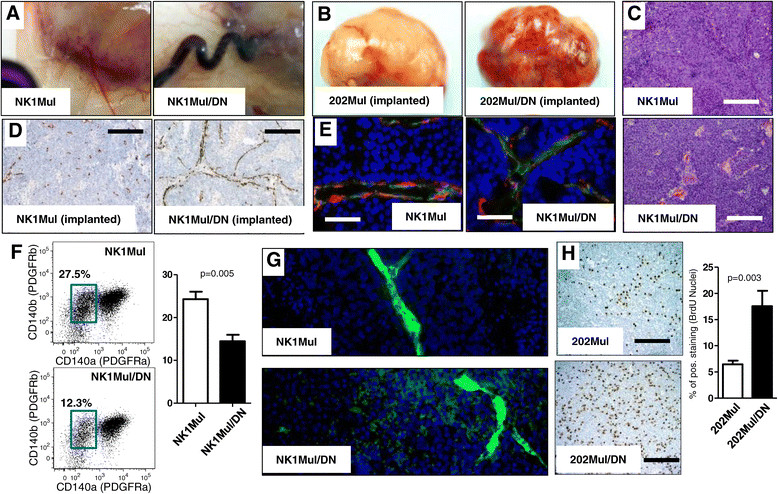Figure 2.

Increased angiogenesis and proliferation in mammary carcinomas of mouse mammary tumor virus (MMTV)-Neu mice with dominant-negative (DN) transforming growth factor β (TGFβ) receptor II (DNIIR). (A) Autopsy of mice with spontaneous tumor formation of the mammary gland, which indicates increased tumor vasculature in mice with DNIIR expression. (B) Isolated tumor tissue on 12th week after implanted carcinoma cells via collagen plugs to the mammary fat pad. (C) H&E staining indicated morphological changes in control (NK1Mul) and experimental mice (NK1Mul/DN). (D) Immunohistochemistry (IHC) staining of frozen sections for endothelial cell marker CD31. Staining was performed with hematoxylin (blue) to counterstain all nuclei. (E) Immunofluoresence staining of frozen sections for the endothelial cells CD31 (green), pericyte marker NG2 (red) and nuclei by 4',6-diamidino-2-phenylindole (DAPI) (blue). (F) Representative fluorescence-activated cell sorting plots and quantitative analysis of pericyte percentage (PDGFRβ+PDGFRα−) in tumor tissue. Cells were gated as non-immune, non-epithelial (CD45−CD326−). (G) Formalin-fixed paraffin-embedded sections of fluorescein isothiocyanate (FITC-)dextran (green)-perfused tumor tissue for indication of vessel leakage. DAPI (blue) was used to counterstain all nuclei. (H) IHC for 5-bromo-2'-deoxyuridine (BrdU) on primary tumors, which indicate newly synthesized DNA in proliferating cells. Quantification of IHC (right) BrdU-positive cells indicates 2.5 times more positive cells in mice with DNIIR than control tissue section. (Scale bars: C, D, E, J, K, 500 μM; F, 1,000 μM).
